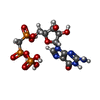+Search query
-Structure paper
| Title | Structure and Dynamics of Single-isoform Recombinant Neuronal Human Tubulin. |
|---|---|
| Journal, issue, pages | J Biol Chem, Vol. 291, Issue 25, Page 12907-12915, Year 2016 |
| Publish date | Jun 17, 2016 |
 Authors Authors | Annapurna Vemu / Joseph Atherton / Jeffrey O Spector / Agnieszka Szyk / Carolyn A Moores / Antonina Roll-Mecak /   |
| PubMed Abstract | Microtubules are polymers that cycle stochastically between polymerization and depolymerization, i.e. they exhibit "dynamic instability." This behavior is crucial for cell division, motility, and ...Microtubules are polymers that cycle stochastically between polymerization and depolymerization, i.e. they exhibit "dynamic instability." This behavior is crucial for cell division, motility, and differentiation. Although studies in the last decade have made fundamental breakthroughs in our understanding of how cellular effectors modulate microtubule dynamics, analysis of the relationship between tubulin sequence, structure, and dynamics has been held back by a lack of dynamics measurements with and structural characterization of homogeneous isotypically pure engineered tubulin. Here, we report for the first time the cryo-EM structure and in vitro dynamics parameters of recombinant isotypically pure human tubulin. α1A/βIII is a purely neuronal tubulin isoform. The 4.2-Å structure of post-translationally unmodified human α1A/βIII microtubules shows overall similarity to that of heterogeneous brain microtubules, but it is distinguished by subtle differences at polymerization interfaces, which are hot spots for sequence divergence between tubulin isoforms. In vitro dynamics assays show that, like mosaic brain microtubules, recombinant homogeneous microtubules undergo dynamic instability, but they polymerize slower and have fewer catastrophes. Interestingly, we find that epitaxial growth of α1A/βIII microtubules from heterogeneous brain seeds is inefficient but can be fully rescued by incorporating as little as 5% of brain tubulin into the homogeneous α1A/βIII lattice. Our study establishes a system to examine the structure and dynamics of mammalian microtubules with well defined tubulin species and is a first and necessary step toward uncovering how tubulin genetic and chemical diversity is exploited to modulate intrinsic microtubule dynamics. |
 External links External links |  J Biol Chem / J Biol Chem /  PubMed:27129203 / PubMed:27129203 /  PubMed Central PubMed Central |
| Methods | EM (helical sym.) |
| Resolution | 4.0 Å |
| Structure data | |
| Chemicals |  ChemComp-G2P:  ChemComp-MG:  ChemComp-GTP: |
| Source |
|
 Keywords Keywords |  STRUCTURAL PROTEIN / STRUCTURAL PROTEIN /  microtubules / microtubules /  tubulin / single isoform / recombinant / dynamic instability tubulin / single isoform / recombinant / dynamic instability |
 Movie
Movie Controller
Controller Structure viewers
Structure viewers About Yorodumi Papers
About Yorodumi Papers






